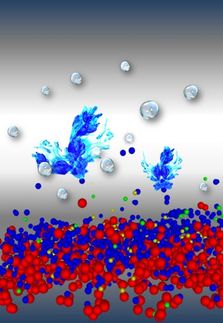Green hydrogen glows pink
Researchers develop a sensor to make hydrogen visible
Researchers at the Department of Chemistry and Pharmacy and the Chair of Thermal Process Technology at FAU have succeeded in making invisible hydrogen gas visible to the naked eye in order to prevent the risk of fires and explosions. The key to their research is what is known as supraparticles, tiny particles that change colour as soon as they come near hydrogen. The results have been published in the journal ‘Advanced Functional Materials’.

Symbolic image
Unsplash/pixabay.com
In future, it is hoped that ‘green’ hydrogen produced using renewable energy will become a key component of a sustainable and climate-friendly energy economy. Although we can neither see nor smell hydrogen gas, it is highly flammable and extremely explosive when it comes into contact with air. Historical events such as the explosion of the Hindenburg Zeppelin and recently also the explosion of a hydrogen refuelling station in Norway show just how important safety precautions are if we are to establish a sustainable and safe hydrogen economy.
In order to increase safety when handling hydrogen, researchers at FAU have explored the fundamental function mechanisms required for an innovative hydrogen sensor, based on a concept developed at the Fraunhofer Institute for Silicate Research ISC in Würzburg. The following researchers were involved in the project: Prof. Dr. Karl Mandel, Professorship of Inorganic Chemistry; Prof. Dr. Jörg Libuda and Dr. Tanja Bauer, Chair of Interface Research and Catalysis; Prof. Dr. Dirk Zahn, Professorship of Theoretical Chemistry; Prof. Dr. Matthias Thommes, Chair of Thermal Process Technology; and Prof. Dr. Andreas Görling, Chair of Theoretical Chemistry.
Hydrogen sensors can successfully recognise even low concentrations of the gas, for example if there is a leak in the pipeline. The innovative hydrogen sensor designed by the FAU researchers consists of tiny particles, known as supraparticles, and can make hydrogen gas visible to the naked eye without electricity or complex equipment. The supraparticles are between one and ten micrometres in size, one micrometer is equivalent to one thousandth of a millimetre, and incorporate the violet-coloured indicator dye resazurin. When they come into contact with hydrogen, the molecules in the dye react and visibly change colour in two different stages. If the sensor turns pink, hydrogen has leaked once. If hydrogen is still leaking, and the sensor is in contact with large quantities of hydrogen, it turns colourless. The immediate reaction makes leaks visible and allows them to be found in real time. A further advantage of the innovative hydrogen sensor is its small size that makes it suitable for use in a number of different scenarios, for example for coating pipelines.
‘The insight we have gained into the workings of the new particle system will allow us to continue to optimise the supraparticles until we can realise their full potential, implement them in real-life applications and make a contribution to a safer hydrogen economy,’ explain the lead authors of the publication Simon Schötz, research associate at ECRC and Jakob Reichstein, research associate at Mandel group.
Original publication
Jakob Reichstein et al.; "Supraparticles for Bare-Eye H2 Indication and Monitoring: Design, Working Principle, and Molecular Mobility"; Advanced Functional Materials; 2022
Most read news
Original publication
Jakob Reichstein et al.; "Supraparticles for Bare-Eye H2 Indication and Monitoring: Design, Working Principle, and Molecular Mobility"; Advanced Functional Materials; 2022
Topics
Organizations
Other news from the department science

Get the analytics and lab tech industry in your inbox
By submitting this form you agree that LUMITOS AG will send you the newsletter(s) selected above by email. Your data will not be passed on to third parties. Your data will be stored and processed in accordance with our data protection regulations. LUMITOS may contact you by email for the purpose of advertising or market and opinion surveys. You can revoke your consent at any time without giving reasons to LUMITOS AG, Ernst-Augustin-Str. 2, 12489 Berlin, Germany or by e-mail at revoke@lumitos.com with effect for the future. In addition, each email contains a link to unsubscribe from the corresponding newsletter.





















































